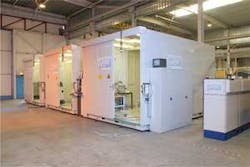Laser joining steel
Martien H.H. van Dijk
Although laser welding technology has become more widely accepted and more accessible in industry, switching from more conventional joining technologies to laser welding demands a careful consideration of both its advantages and disadvantages.
Compared to traditional joining technologies like resistance welding, plasma welding, and brazing, the advantages of laser welding include a small heat affected zone, higher welding speed (if the process allows), and less post processing. Disadvantages include higher investment costs and narrow tolerances on parts to be joined. However, in many cases, it may turn out that a laser-based solution to the joining problem is, indeed, cost effective.
Before selecting a new production unit, give thorough consideration to all alternatives, regardless of whether you intend to revamp the entire manufacturing process or replace just a part of it. Consider the way the production unit will be used. A system producing small series (up to 10 products per month) needs to be equipped differently than machines that will produce 1200 products per day.
Today a wide variety of laser sources are available. In addition to CO2 and Nd:YAG lasers, users also can consider disc and fiber lasers. Furthermore, the choices in part handling and beam manipulation will also affect the final production cost.
All these considerations require close cooperation, from very early stages on, between the machine tool builder and the end users. An increasing number of machine tool builders and system integrators have the know-how and capability to offer their customers a choice between traditional joining technologies on the one hand and laser joining and hybrid welding on the other.
A successful collaboration
When Bisley (Woking Surrey, UK; www.bisley.com), a manufacturer of steel office furniture, was looking to improve production efficiency, it turned to system integrator AWL-Techniek (Harderwijk, The Netherlands; www.awl.nl). Bisley produces a complete range of steel storage equipment to satisfy all office requirements, including a recently launched high-density mobile storage filing system. Until recently, for the production of drawers Bisley joined the fronts by means of gas welding, which was qualitatively good but not as efficient as possible. Together the companies investigated several options. The most difficult problem to deal with was the fact that paint had to hold on the weld. AWL-Techniek offered the solution by working out a concept for laser welding.
The final production unit consists of a diode laser mounted on a robot arm. The larger spot size of the diode laser is, for this application, an advantage over the spot size of a CO2 or Nd:YAG laser. The use of a robot makes 3D welding possible.
The concept is based on one of the basic modules from the range of standard modules that AWL-Techniek offers. They consist of a cabin mounted on a frame, a turning table, and a number of robots. The jig and the controls are specific for the application. One of the standard modules was adapted for the specific needs of laser welding of the components of steel office furniture. Critical evaluation of the specific needs led to a highly efficient and very simple installation.
The main advantage of the application of laser welding over the old installations is the fact that there is no post processing necessary. The products produced from the gas welding installation needed to be manually grinded, which was very cost intensive.
Choosing the right system integrator was a key factor in Bisley’s success. AWL-Techniek was able to leverage its diverse knowledge base, and come up with the best solution for Bisley’s situation.
Evolving to laser
Started 11 years ago as a manufacturer of resistance welding equipment, AWL-Techniek has evolved into a system integrator specializing in joining technology. Besides resistance welding, the company built up vast experience in arc welding and cold formed joints. In early 2003 the company hired Leo van der Burg, a laser welding expert from a former laser research center in the northern part of The Netherlands.
AWL-Techniek organizes all kinds of laser welding and cutting studies for its customers and potential customers. It developed a laser welding and cutting facility that consists of three cabins. One cabin can be used for laser hybrid welding, one for laser cutting, and one for laser welding. The equipment is also used for feasibility studies, welding tests, and start-up production if the customer has to deliver products before its production unit is delivered.
As a system integrator for joining equipment, the company realized that state-of-the-art production equipment must be flexible and designed for the future. AWL-Techniek prides itself on being a versatile specialist in the field of integrating joining technology. It selects not only the best technology but also the most efficient machine concept.


